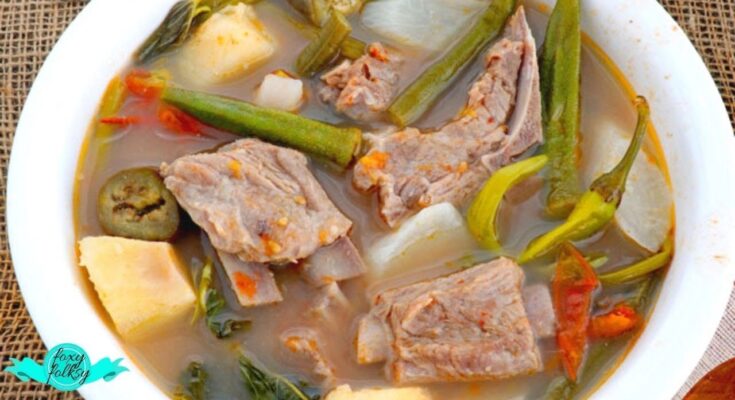Sinigang Recipe: Sinigang is a classic Filipino soup known for its sour and savory flavor. It’s a versatile dish traditionally made with a tamarind base, which gives it its signature tang. This comforting stew often includes meat, seafood, or vegetables, making it a household staple in the Philippines.
Why is Sinigang a Beloved Filipino Dish?
Ask any Filipino, and they’ll tell you that Sinigang holds a special place in their heart—and their taste buds! Its warm, sour, and hearty profile is perfect for family gatherings, rainy days, or simply when you need a comforting meal.
Key Features of Sinigang
- Distinct sourness from tamarind or similar ingredients
- A mix of tender meat or seafood and fresh vegetables
- Versatile to suit dietary preferences and available ingredients
Ingredients Needed for Sinigang
Primary Ingredients
- Protein of choice: Pork belly, shrimp, beef short ribs, or fish
- Sour base: Tamarind paste or fresh tamarind pods
- Vegetables: Radish, eggplant, okra, string beans, water spinach (kangkong), and tomatoes
- Flavor enhancers: Onion, garlic, and fish sauce
Optional Additions to Customize Your Sinigang
- Green chilies for a spicy kick
- Knorr Sinigang Mix for convenience
- Taro root for extra creaminess
Ingredient Preparation Tips
- Always rinse your vegetables thoroughly to remove dirt.
- Slice ingredients into uniform pieces to ensure even cooking.
- For tamarind pods, boil and strain to extract the juice.
Tools and Equipment You’ll Need
Cooking Essentials
- A large pot for simmering the soup
- A sharp knife for chopping vegetables and meat
- A cutting board
Tools for a Seamless Sinigang Preparation
- Soup ladle for serving
- Fine mesh strainer (if using fresh tamarind pods)
Step-by-Step Sinigang Cooking Instructions
Step 1 – Prepare the Ingredients
- Wash and cut all vegetables into bite-sized pieces.
- If using tamarind pods, boil them in water and mash to extract the juice. Set aside.
- Cut the meat into chunks or clean your seafood thoroughly.
Step 2 – Sauté and Simmer
- Heat oil in a large pot and sauté chopped onions, garlic, and tomatoes until softened.
- Add your chosen meat and brown it slightly to lock in the flavor.
- Pour water or stock into the pot and bring it to a boil.
Step 3 – Add the Tamarind Base and Vegetables
- Stir in the tamarind juice or Sinigang mix. Adjust the amount based on your preferred sourness.
- Add harder vegetables like radish and eggplant first since they take longer to cook.
Step 4 – Simmer and Season to Taste
- Once the vegetables are partially cooked, toss in the leafy greens and softer vegetables.
- Season with fish sauce, salt, and pepper as needed. Allow it to simmer until everything is tender and flavorful.
Tips for Perfecting Your Sinigang
Balancing the Flavors
A good Sinigang strikes the right balance between sour, savory, and slightly sweet. Taste frequently and adjust as needed.
Adjusting the Sourness
Too sour? Add a pinch of sugar. Not sour enough? Stir in more tamarind paste or juice.
Common Mistakes to Avoid
- Overcooking the vegetables—they should remain vibrant and slightly crisp.
- Adding too much tamarind at once without tasting.
Popular Variations of Sinigang
Pork Sinigang
The most traditional version, usually made with pork belly or ribs for a rich and flavorful broth.
Shrimp Sinigang
Light and refreshing, this version is perfect for seafood lovers.
Beef Sinigang
Beef short ribs or brisket add a hearty twist to this classic dish.
Vegetarian Sinigang
Skip the meat and load up on more vegetables like taro, mushrooms, and tofu.
Serving Sinigang Like a Pro
Best Side Dishes to Pair with Sinigang
- Steamed rice (a must!)
- Fried fish or grilled meat for added texture and flavor
Presentation Tips for an Authentic Experience
Serve Sinigang in a traditional clay pot to keep it warm longer and enhance its aesthetic appeal.
Health Benefits of Sinigang
Nutritional Value of the Ingredients
The dish is packed with vitamins and minerals from the fresh vegetables, while the tamarind provides antioxidants and aids digestion.
How Sinigang Supports a Balanced Diet
Sinigang is low in fat (depending on the protein) and high in fiber, making it a great addition to a balanced meal plan.
FAQs about Sinigang Recipe
What is Sinigang?
Sinigang is a popular Filipino soup known for its savory and tangy flavor profile. It’s typically made with pork, beef, or seafood and a variety of vegetables, simmered in a broth soured with tamarind, green mango, or other souring agents.
What are the common ingredients in a Sinigang recipe?
The typical ingredients for Sinigang include a protein like pork, shrimp, or fish, vegetables such as water spinach, radish, eggplant, and string beans, and a souring agent like tamarind paste or fresh tamarind. Tomatoes and onions are also essential for building the base flavor.
How do you make the broth sour in Sinigang?
The sourness in Sinigang can be achieved using several ingredients. The most traditional is tamarind (fresh, paste, or powder), but alternatives like green mango, calamansi, or even lemon can be used depending on the desired tanginess and availability of ingredients.
Is there a vegetarian version of Sinigang?
Yes, Sinigang can easily be adapted for a vegetarian diet by omitting the meat and increasing the variety of vegetables. Some people also use tofu as a protein substitute in vegetarian Sinigang.
How long does it take to cook Sinigang?
The cooking time for Sinigang can vary based on the type of protein used. Pork or beef might take about 45 minutes to 1 hour to become tender, while seafood versions like shrimp or fish typically take less time, about 20 to 30 minutes.
Can Sinigang be made in advance?
Sinigang is perfect for making in advance as the flavors continue to develop and meld when stored in the refrigerator. It can be stored for up to 3 days and reheated, making it a convenient and flavorful meal option throughout the week.
What do you serve with Sinigang?
Sinigang is typically served with steamed rice to balance the tangy flavor of the soup. It can also be paired with a fish sauce on the side for an extra kick of umami.



